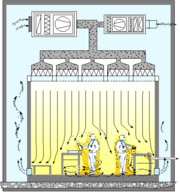& the pics, funny how VPD breaks down the clorophyl in the leaves, mine seemed to dissolve-(the green colour), leaves were showing like a Mg def but the leaf coulour turned 'Golden', very similar to your pics. nice example btw.
Is possible you are talking about photorespiration?the upper part of the plant,with a lot of light and low RH,can be affected by photorespiration quite easily.Also fans that blow air on the leaves increase photorespiration.
I say this because you wrote ''golden'' and my mind think to this...




